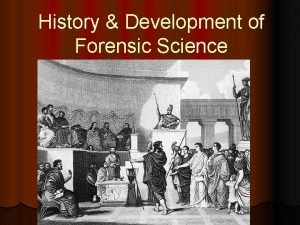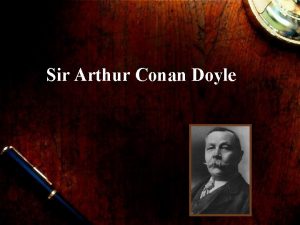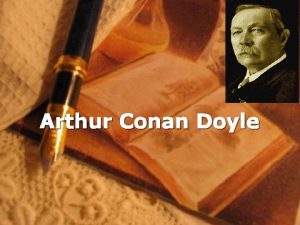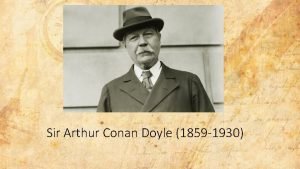Week 3 Private Investigators Arthur Conan Doyle The








- Slides: 8

Week 3: Private Investigators Arthur Conan Doyle, ‘The Speckled Band’ (1892) C. L. Pirkis, ‘Drawn Daggers’ (1893)

Arthur Conan Doyle (1859 -1930) • Born 1859 in Edinburgh. He was educated at a Catholic boarding school and later studied medicine at the University of Edinburgh. Sherlock Holmes was supposedly inspired by one of his professors, Joseph Bell. • In 1882, Conan Doyle set up a general practice in Southsea (near Portsmouth), but began writing fiction while waiting for patients. • A Study in Scarlet - the first novella featuring Sherlock Holmes – was published in 1887. The character subsequently appeared in three more novels and 56 short stories. • Holmes’s popularity grew – commercial success. Conan Doyle tried to kill off Holmes in ‘The Final Problem’ (1893). Brought back by popular demand. • The original canon spanned the 1880 s-1920 s. • Conan Doyle wanted to be better known for his more ‘serious’ historical fiction. • Personal life – married his first wife Louisa Hawkins in 1885. After her death in 1906, he married Jean Beckie. • A later convert to spiritualism (perhaps due to his son Kingsley’s death in 1918). Interested in contact between the living and the dead. • He died in 1930. The Arthur Conan Doyle Encyclopedia Private Collection. (Public Domain) https: //www. arthur-conandoyle. com/index. php? title=Sir_Arthur_Conan_Doyle: B iography

C. L. Pirkis (1841 -1910) • Charlotte Louisa Pirkis was born in 1841. • She published her first book in 1877; wrote 14 in total. Also a writer of romantic melodramas. • Six Loveday Brooke mysteries appeared in the Ludgate Monthly, a ‘family magazine’. ‘Drawn Daggers’ was the fifth of these. The stories (plus one more) were gathered in Pirkis’ last book, The Experiences of Loveday Brooke, Lady Detective. • She published her first two novels under the name Mrs Fred E. Pirkis, and later as C. L. Pirkis. • Pirkis retired from writing fiction in 1894. • She was married to a naval officer. Together they co-founded the National Canine Defence League, an influential animal rights group (now the Dogs Trust).

Sherlock Holmes • ‘Consulting detective’ • Freelance. Amateur or professional? • Gentleman sleuth, decadent. • Analytical and reasoning skills – close observation, deductions. • Scientific in his method – relies on logic rather than chance. • ‘How often have I said to you that when you have eliminated the impossible, whatever remains, however improbable, must be the truth? ’ - The Sign of Four (1890). • Sidekick – companion Dr Watson. • Works with the police – Lestrade. • Arch nemesis – Moriarty – ‘A criminal strain ran in his blood’ (‘The Final Problem’, 1893). Illustration by Sidney Paget for ‘The Speckled Band’ in Strand Magazine (February 1892). https: //www. arthur-conandoyle. com/index. php? title=Sidney_Paget

Loveday Brooke • Earlier women detectives: • Mrs Paschal in Revelations of a Lady Detective (1861/4; attributed to W. S. Hayward). • Mrs/Miss Gladden in The Female Detective by Andrew Forrester Jnr (1864). • First female detective by a woman author? • Loveday Brooke works for a private detective agency run by Ebenezer Dyer. • Professional woman, no sidekick or companion. Illustration by Bernard Higham for ‘The Black Bag Left on a Doorstep’ in The Experiences of Loveday Brooke (1894) http: //digital. library. upenn. edu/women/pirkis/brooke. h tml • The name Loveday comes from the Latin dies amoris, which means a day set aside for peacefully settling disputes (Michelle Slung).

Historical and Literary Context: Reading and Print Practices • Changing format of fiction • Shift in trends from the novel to short story form. • Fiction becoming cheaper – growth of paperbacks, short stories. • Growth of a mass market for fiction • Census data shows that between 1851 to 1900, male literacy rose from 69. 3% to 97. 2% while female literacy grew from 54. 8% to 96. 8%. • From 1870, a series of Education Acts – compulsory education for children 5 -13. • a young, educated readership with little cash. • Doyle’s first Holmes story was a ‘shilling shocker’ and the Strand Magazine sold for sixpence. • Ludgate Magazine sold for threepence in the 1890 s. • Cheaper costs of production and distribution • Development of the periodical press – new titles, wider circulation. • By 1890 s, around 800 weekly papers in Britain, 240 carrying ‘some variety of detective fiction’. (John Sutherland) • Gas and electric lighting – easier to read.

Critical Reception: Legacies ‘Doyle expertly achieved the right balance of elements to provide the male middleclasses with relaxing reading which flattered them by providing an intellectual adventure, while assuaging their anxieties about the modern world. The stories celebrate the materialism of the age, showing that the ordinary small objects of everyday existence, if observed properly, have stories, create atmospheres, point directions. At the same time, they celebrate the capacity of rationalism to organise the material of existence meaningfully, and the power of the rational individual to protect us from semiotic and moral chaos. Yet the crimes are rarely excessively troubling (and, although we do find murders, on the other hand in many stories there is no crime at all). Holmes deals largely with family irregularities and the consequences of selfishness, rather than dangers endemic to the system. ’ - Martin A. Cayman, ‘The Short Story from Poe to Chesterton’ (2003).

Critical Reception: Legacies ‘Any woman undertaking detection, whether amateur or professional, becomes transgressive. ’ ‘[I]n the female detective novel, the protagonist/ detective not merely grasps the empowering gaze from the male but may, even more subversively, implode all gendered hierarchies. ’ - Joseph A. Kestner, Sherlock’s Sisters (2003).













